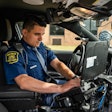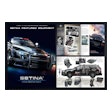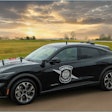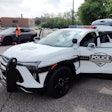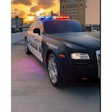Like many officers, you will easily remember the thrill of your first police pursuit. In my case, it involved a stolen vehicle with a young male driver. It was a short chase, as the inexperienced driver collided with a telephone pole and snapped his leg. Car recovered, driver arrested, excited young cop. Since then, I have been in other pursuits, but they tend to blur with the years. And our department, like many, has put tighter and tighter restrictions on pursuing fleeing vehicles.
I agree with these new policies. The risks created by fleeing drivers to the motoring public and police officers can be very serious. Great weight needs to be placed on allowing suspects to compound those risks further with each yard they recklessly drive to escape apprehension. The value of pursuing bad guys vs. terminating chases is strongly debated in the law enforcement community.
There are merits to both views, but the intent of this commentary is not to delve too deeply into the legal, moral, and ethical aspects of chasing bad guys. It is to present a cost-effective training model that addresses two critical aspects of police pursuits for both the officer and his or her agency: policy compliance and decision making for all aspects of a police pursuit.
The Need
Although there are plenty of solid training programs that address the physical operation of cruisers in pursuit conditions-such as driving tracks or simulators-it is sometimes difficult for agencies to train all of their personnel in this manner. Due to logistics or budget issues, a department may send only a handful of officers or schedule officers incrementally. Another option is in-house instruction where a department trainer provides pursuit exercises for officers to practice. A lack of suitable open locations to drive or overtime concerns may prohibit this type of training. But due to the critical nature of emergency vehicle operations, agencies need to find ways to keep their officers' driving skills at a high level.
Making sure police officers can drive well is not enough. They must also keep their mental skills just as sharp to follow policy under stress and exercise good judgment throughout the pursuit. It is interesting that the state academy in Ohio offers a course called Pursuit Termination Techniques that teaches officers, among other things, how to use the Precision Immobilization Technique (PIT) and tire deflation devices. These important actions can help effectively stop a pursuit, but what isn't mentioned in the course description is developing the ability to decide whether to pursue. The skill to discern when to begin a pursuit is every bit as important as being able to bring one to a successful resolution.
Set-up and Students
Using existing cruiser cameras or a standard video recorder, a trainer takes videos of officers following various cars driven by other officers or volunteers on local streets and highways. These videos could include the "suspect" vehicles coming to a stop and even involve occupants' actions like fleeing from the vehicle. Videos from actual pursuits involving agency officers can also be used if available. If none are available, an effort should be made to utilize pursuit video from neighboring agencies as their roadways may be familiar to your department.
To simulate the pursuit environment for training purposes, set up two tables, a television (preferably a large screen), a video player, an old radio mic from a cruiser, an out-of-service phone, and an old dispatch radio mic. Officers, dispatchers, and supervisors should participate in the training model as each plays an important role in helping to ensure a safe outcome.
Training Model
The training begins with a full review of the department's pursuit policy. An officer's compliance with department policy is vital to the success of any police pursuit. Place special emphasis on portions of the policy that address the decision to pursue by the officer. It is during this critical moment that an officer must decide if there are enough elements to begin what may be the most dangerous action this officer will take. The risks are not only high for the officer, but they are particularly serious for the motoring public, as well as the pursued suspect. It is important that the officer's decision be in compliance with allowable pursuit situations.
Sometimes policies are written with general phraseology that doesn't always provide the bright lines that officers or supervisors may prefer. Instead, an officer will have to articulate how specific facts or observations support that initial decision. If an agency doesn't have a policy on pursuits, the officer must apply these same facts and observations with departmental practice and its culture.[PAGEBREAK]
Focus on the officer as he or she reports the conditions involved with the pursuit, such as the type of violations that led to the attempt to stop the vehicle, road conditions, and traffic. If your policy doesn't require an officer to provide this information, consider including it. This intelligence could help a supervisor decide whether to override an officer's decision to pursue.
After a review of the policy, the officer sits in front of a television with a radio mic to simulate the officer's cruiser mic. The dispatcher and supervisor sit at another table with a radio mic taped to the table and a telephone. The dispatcher/supervisor table should be angled away from the video being observed by the officer to allow the dispatcher to rely only on radio traffic during the exercise.
After a brief introduction of the scenario by the trainer, the video is shown to the officer. Scenarios could range from minor traffic violations to armed robbery suspects fleeing a scene. Of particular importance is the officer's decision of whether to pursue or when to stop based on the circumstances provided by the trainer. If a decision is made to pursue, the officer begins radio transmission to the dispatcher related to the observed video, including locations, descriptions, license plate information, and reasons for the attempt to stop the vehicle.
The dispatcher responds to the officer's radio transmissions, handles responsibilities per policy or protocol, and practices operating the phones to advise other agencies of the officer's pursuit. The supervisor listens and oversees the pursuit. The supervisor may interject where needed, such as an attempt to solicit information from the officer that she or he may not be relaying to dispatch or to advise the officer to stop the pursuit due to the conditions involved.
As the pursuit continues, the officer watches the driving actions of the suspect and continues to radio the information to dispatch. By using video from the agency's city or county, the officer should be able to recognize streets and relay that information to the dispatcher. Also, if the suspect driver or occupants act a certain way within the vehicle, the officer should radio these observations, as well. Actions from the driver or occupants could include tossing possible evidence from a window or drawing a weapon from inside the vehicle.
The trainer can add information during the pursuit that may change how the officer proceeds. If high velocity weapons are observed, the officer may set his cruiser much farther back on the highway, make himself a smaller target within the cruiser, and begin variations in his driving pattern. Actively explaining actions based on the circumstances is one of the benefits of this training as it makes the officers think about what they are doing and why.
Like a Table Top Exercise
If a scenario has the suspect vehicle come to a stop, the officer will advise the trainer what his actions would be at that point. Possibilities could include setting up for a high-risk traffic stop or pursuing after a suspect that flees on foot. If one occupant runs while others stay in the car, the officer provides a description of the suspect for other units while he maintains cover on the vehicle.
This portion of the training is similar to table top training exercises where the participant describes how the situation should be handled from tactical, geographical, and logistical perspectives. It would be beneficial to have a city/county map available to enable an officer to outline how his or her perimeter should be set up after a suspect(s) flees. Directing how the action should proceed also allows officers to demonstrate leadership capabilities.
Evaluation
After each scenario, the trainer will discuss the actions of the participants and obtain feedback from them. It is a good opportunity to determine whether the right decisions were made and how well each participant complied with policy and their responsibilities during the scenario. The officer is evaluated on his or her decision making, compliance with departmental policy, and radio operations while dispatchers are evaluated on their compliance with policy, along with the operation of the radio and phone. The supervisor is evaluated on policy compliance, as well as his overall decision to allow a pursuit to continue.
Training Value
The dangers and stress from the emergency operation of police vehicles in a pursuit is an important matter for police officers, their agencies, and the public, especially those operating on the street at the same time. Officers are required to negotiate cruisers safely in all types of road and weather conditions while simultaneously watching the subject vehicle, operating the cruiser, and radioing information. It is important that they demonstrate strong driving skills, good judgment, and understand their agency's expectations of them during a police pursuit. This relatively inexpensive training model can provide some important instruction and practice on the decision-making, policy compliance, and radio operations for police pursuits.
Tom Wetzel is a northeast Ohio suburban police lieutenant, SWAT officer, trainer, and certified law enforcement executive.









